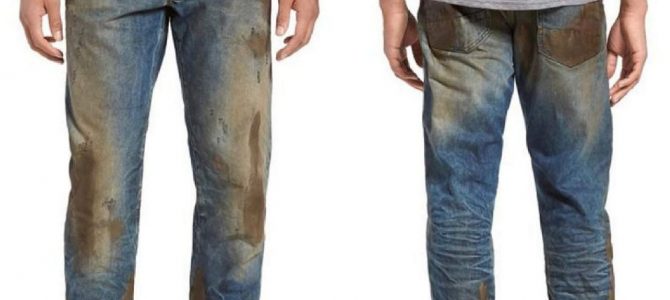
Let him or her who is without fashion sin cast the first stone: surely on this, culture conflicts aside, we could all agree. At least until Nordstrom debuted its now-viral $425 (ugh) “mud”-caked (eww) straight-leg (gahhhh) jeans. As you already know, this garment perfectly expresses what’s wrong with America. But the reason why may be more complicated than anyone wants to admit.
For starters, Nordstrom should be paying men to wear straight-leg jeans, the one artifact of the ‘90s that should never have been retrieved from the coffin designers locked it in, wrapped chains around, and festooned with knobs of garlic. Even for all-American average men, jeans are pants, not a punishment, which straight legs inflict by plunging the wearer deep into the uncanny valley between comfort-casual and Obama-awkward. If you want to slouch around, there are whole lines of sweatpants—classic and contemporary—to choose from. If you don’t, a bounty of khakis await.
And don’t think hipsters have ruined consciously considered denim: love or hate skinny jeans, tight jeans never go out of style if you fit in them, and if you don’t, the racks of popular and upscale clothing stores groan with tapering jeans, drop-crotch jeans, and, yes, even boot-cut jeans a male person can pull off without trying too hard. The cold fact is, if the garment in question was a fake-filth-splattered ripoff that Derek Zoolander would actually wear, there’d be little here worth the time that it takes to complain.
This Is Going Somewhere Nobody Wants to Be
This monstrosity, however, exists, and its abominable mishmash of style cues is an intolerable fit on a cultural level, not just a dressing-room one. Historically, weird jeans have not been worth worrying about online since at least the first iPhone came out: like the latest gadgets, they were prized by early adopters—hipsters and fashion people—whom the rest of the general population stayed content to let revel in their own peculiarity. But the “mud” jeans augur a newly horrible prospect, of not only weird but gross jeans making their way to the mainstream.
We’ve known for ages that wealthy people looking to project a certain on-trend image can be suckered into adopting newfangled costumes no self-respecting fashionista or terminally snobby hipster would dare take out in public.
This is a step further: while relentlessly distressed acid-washed denim or mom jeans with clear plastic knee inserts might catch low-grade heat for a hot minute, the “mud” jeans are now—by design, we’re nauseatingly certain—on the same culture level as the is-it-or-isn’t-it-black-and-blue-dress. They’re something the proverbial “everyone” online knows about, is experiencing. The worst weird jeans ever are now a part of our lives. How could they!
Maybe This Is an Opportunity to Extend Grace
It must be a devilish—rapacious, capitalist, opportunistic, plutocratic—plot, the ten-dimensional chess of feeding class conflict back to the 1 percent at exorbitant rates. It’s got to be a bid to prove just how easily those who control the means of production can colonize our minds, an intentionally farcical way of pulling our puppet strings, proving our powerlessness.
“Heavily distressed medium-blue denim jeans in a comfortable straight-leg fit embody rugged, Americana workwear that’s seen some hard-working action with a crackled, caked-on muddy coating that shows you’re not afraid to get down and dirty,” Nordstrom’s own description of the jeans explains—an apt metaphor, no doubt, for the bankrupt zombie machismo that decadent upper-class men must now co-opt to survive the systematic destruction of the American dream they’re so complicit in having created to imprison their competition in a barred and gilded imaginarium.
Maybe. Maybe. But what if they’re better seen as an accident, one of the endless number of half-baked experiments gone wrong in the dumb, evanescent, ultimately insignificant space where worn-out trends, trivial technology, disposable income, and idle consumers of social media meet? What if, the more conscious we become of the deep meaninglessness of these accidents, the more we claw back little units of our attention, agency, and associational authority without descending into another layer of sociopolitical distemper?
Confrontational popular action doesn’t need these jeans to mobilize shared change agency. In fact, it’d be better off without them. As would we all. Some things, as they say, can’t be unseen. But if the fickle finger of fashion teaches us one thing, it’s that sometimes, the worst can be forgotten, even when we fall too short in remembering how to forgive.









